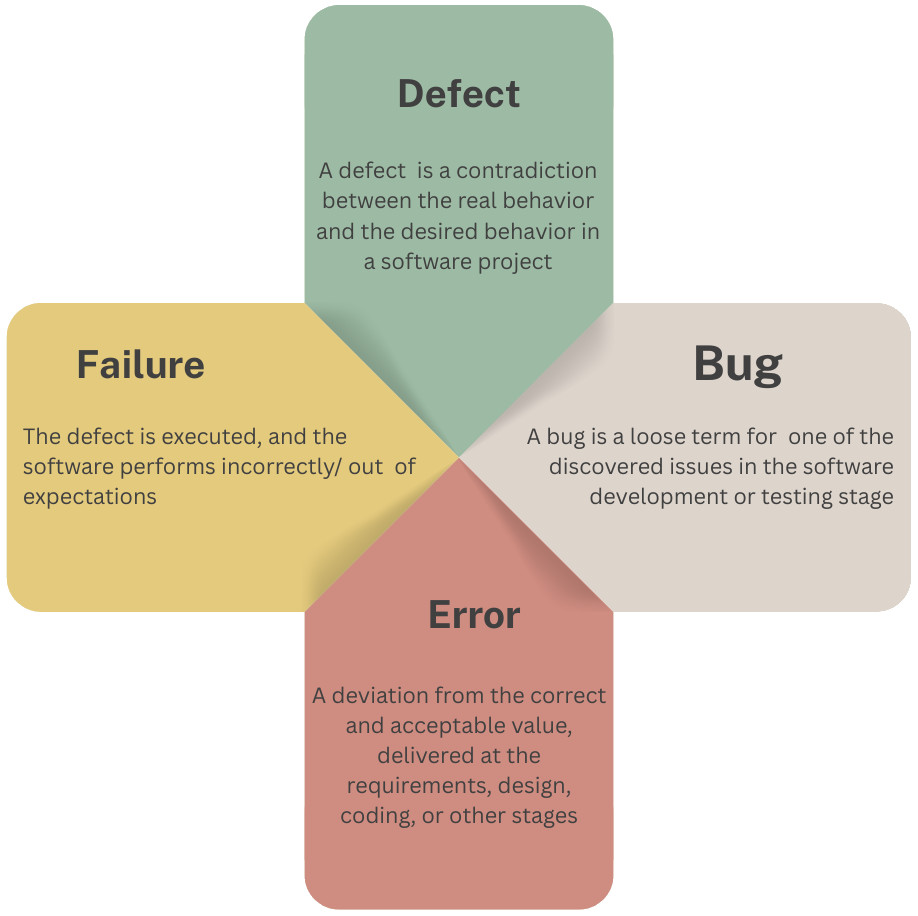What is Defect Leakage in Software Testing?
|
|
Software testing is one of the integral stages of the Software Development Life Cycle (SDLC). It guarantees the application is stable, working, and compliant with its specifications prior to delivery to the customer. Nevertheless, despite extensive testing, bugs can still slip through into the downstream or even into the production environment. This is referred to as defect leakage.
Defect leakage is a major concern for testing teams, affecting customer satisfaction, brand reputation, and sometimes even revenue. Whatever the case, the knowledge of defect leakage, its reasons, ways of measurement, and the means of reducing it should be known to every QA, developer, project manager, or product owner.
Key Takeaways
- You will learn about defects, bugs, errors, and failures.
- What is defect leakage, and why should you track it through metrics?
- Effects, causes, and ways to prevent defect leakage.
- Difference between defect leakage and defect escape.
- Learn formulae related to defect leakage and how to calculate them.
Understanding Defects in Software Testing

Before we can understand more about complex concepts like defect leakage, we need to form a solid foundation. In other words, what are defects, and how do they relate to terms such as bug, error, and failure?
- Defect: It is a contradiction between the real behavior and the desired behavior in a software project. For example, if the requirement says that clicking the “Submit” button should send an email confirmation, but nothing happens, that is a defect.
- Bug: It is a loose term for one of the discovered issues in the software development or testing stage. For example, a missing field validation that allows users to submit a form without filling out mandatory details would be referred to as a “bug.”
- Error: A deviation from the correct and acceptable value, delivered at the requirements, design, coding, or other stages, that can be a defect. For example, a developer incorrectly writing a formula to calculate tax is an error.
- Failure: The defect is executed, and the software performs incorrectly or contrary to expectations. For example, if a banking app crashes when trying to transfer more than $10,000, the crash is a failure.
What is Defect Leakage?
The defect leakage is the percentage of defects that are missed in a specific testing phase and are found in the next phase (Testing phase (ST into UAT) or with external customers after the software is delivered) or leak onwards into production.
In simple terms, we can say that during testing, the QA team aims to find all the defects. However, some defects slip through, and then they will be found later by another testing team or by customers once the product is released. Thus, lower defect leakage indicates a stronger, more thorough testing process, while higher defect leakage suggests that testing was incomplete or ineffective.
Why Defect Leakage Matters
- Measures Testing Effectiveness: It’s an indication of how well the specific testing stage is capable of capturing defects before release.
- Indicates Risk to Production: Leaked defects can lead to a negative customer experience, brand impact, revenue reduction, or even a system crash.
- Identifies Weak Testing Areas: Regular defect leakage indicates that some weak points exist within your test cases, testing areas, or understanding of the requirements.
- Drives Process Improvements: Organizations use defect leakage data to fine-tune their testing practices, support quality gates, and train teams.
How Defect Leakage Occurs
Defect leakage can occur for several reasons:
- Incomplete Test Coverage: When not all functionality, use cases, or edge cases are tested, bugs in the non-tested components will slip through to successive levels. Read: What is Test Coverage?
- Poor Test Case Design: Less specific, vague, or incomplete test cases do not properly test the application and leave bugs undetected.
- Insufficient Understanding of Requirements: When testers misunderstand or overlook essential requirements, they cannot properly test crucial functionalities, resulting in unidentified defects.
- Tight Deadlines Leading to Rushed Testing: If teams are under pressure to deliver fast, the testing could be rushed or abbreviated, and that’s when significant defects don’t get detected.
- Complex Integrations Between Systems: Leaks usually occur when many systems interact in complicated ways, and integration tests are not comprehensive or cannot cover real-world cases.
- Miscommunication Across Teams: When developers, testers, and business stakeholders do not communicate properly, mismatched expectations occur, and these validations can be missed, and defects remain undetected.
- Environment or Data Mismatches: A testing environment or test data that do not accurately resemble the production configuration can lead to bugs, which are only discovered in the live environment, being overlooked in testing. Read: Managing Your Test Environment.
- Human Errors in Execution: A few oversight errors in test execution, such as skipping steps or misreading results, could cause testers to overlook defects that should have been discovered.
Effects of Defect Leakage
Defect leakage doesn’t just affect the quality of software; it ripples across the business, development team, customer base, and company reputation.
- Business Impact: When customers run into bugs on their apps in production, it means abused trust, unhappy customers, or even lost revenues from downtime and poor user experience.
- Increased Cost: Correcting bugs after a product is released is much costlier than during the development because it can involve patches, rework, retesting, and, in severe cases, even compensation for the end users. Read: Minimizing Risks: The Impact of Late Bug Detection.
- Team Morale: Persistent leaks can be a source of frustration for your QA team and developers if they feel they’re not being effective, leading to lower morale and a lack of motivation.
- Delayed Deliveries: Leaked defects that need to be addressed imminently result in development teams being pulled off scheduled projects to deliver hotfixes, delaying projects, and missing delivery dates.
- Reputation Damage: Recurring problems in shipped code eat away at a company’s reputation and brand, and can lead to negative reviews, lost clients, or bad press.
Defect Leakage vs Defect Escape
Though often used interchangeably, Defect Leakage and Defect Escape refer to distinct moments in the defect lifecycle and have different scopes of impact.
| Aspect | Defect Leakage | Defect Escape |
|---|---|---|
| Definition | Defect that was missed in one testing phase and found in the next | Defect not caught in any testing phase and found in production |
| Stage of Detection | Before release | After release |
| Impact Level | Moderate | High |
| Responsibility | Specific test phase failure | The entire test cycle failure |
| Typical Detector | QA team in the later stages | End user or client |
Defect Leakage Formula
Defect Leakage (%) = ( Number of defects found after release / Number of defects found before release ) x 100
Defect Leakage (%) = ( Defects detected in later phases / Total defects detected in earlier phases + later phases ) x 100
- Defects found during testing = 90
- Defects found after production = 10
Defect Leakage = ( 10 / 90 + 10 ) x 100 = 10%
Metrics Related to Defect Leakage
While Defect Leakage helps measure how many defects slip through a particular testing phase, it’s most powerful when analyzed alongside other complementary QA metrics. These additional metrics provide a broader picture of the testing process’s effectiveness, software quality, and team responsiveness.
Defect Density
Defect Density = Total number of confirmed defects / Size of the software module
The size is generally expressed in KLOC. This metric helps to measure how many bugs are present in a chunk of code. It also helps to know which modules or components are more error-prone, thus directing targeted improvements. For example, if a module contains 10 defects and has 5,000 LOC, the defect density is two defects per KLOC.
Defect Detection Percentage (DDP)
DDP = (defects found in testing / total defects found) x 100
DDP measures the effectiveness of the testing team in intercepting bugs before going live. A higher DDP implies that most of the defects are caught during the internal testing, and a lower DDP signifies more of the defect leakage or escape. For example, if 80 defects are found in testing, and 20 are found later, then DDP = (80 / 100) x 100 = 80%.
Mean Time to Detect (MTTD)
MTTD = Sum of time of all defects detected / Sum of total number of Defects
MTTD measures how long it takes the team to discover faults once they are introduced or activated. Low MTTD implies faster feedback loops and more effective handling of defects during development or testing. For example, detection time is 100 hours with 5 defects found then MTTD = 20 hours.
Mean Time to Repair (MTTR)
MTTR = Sum of time to fix all defects / Number of defects that have been fixed
MTTR is the average amount of time to repair a defect once it’s discovered. A low MTTR indicates that there is good developer discipline in addressing defects and a good defect management system. For example, 10 bugs in total, over 50 hours to fix, MTTR =5 hours.
Individually, these metrics provide insight into specific aspects of defect management:
- Defect Density identifies risky areas of code.
- DDP shows how effective testing is at catching bugs.
- MTTD and MTTR help measure the responsiveness and agility of the QA and development teams.
Together, they allow teams to:
- Benchmark the efficiency of testing.
- Monitor the health and stability of the product.
- Identify areas that need more rigorous testing or code review.
- And improve defect prevention and resolution strategies.
Defect Leakage Reporting and Documentation
Proper documentation and reporting of defect leakage are critical for identifying weaknesses in the testing process, enabling continuous improvement, and ensuring accountability across teams. A well-prepared defect leakage report provides transparency, learning, and a basis for process optimization.
| Component | Description |
|---|---|
| Number of Defects Leaked | Total missed defects found in later phases or production |
| Root Cause Summaries | High-level reason for each defect’s escape |
| Impact Analysis | Business or technical consequences of leakage |
| Phase Where It Should Be Caught | Stage where the defect ideally should’ve been detected |
| Recommendations for Improvement | Specific steps to strengthen defect detection |
| Regular Reporting | Ensures process visibility and continuous improvement |
How to Prevent Defect Leakage
Defect leakage can be minimized through proactive, structured quality practices that enhance test accuracy, coverage, and collaboration across the development lifecycle.
Requirement Clarity Sessions
By engaging testers early in the requirements dialogue, they are aware of the functionality to be delivered and can design test cases that are less frivolous and more comprehensive.
- Benefit: Reduces misinterpretation and ensures test coverage aligns closely with business expectations.
Better Test Case Design
Write test cases for all paths, both positive and negative, as well as edge cases, boundary conditions, and unexpected user behavior.
- Benefit: Increases the likelihood of catching subtle, real-world defects before they leak.
Peer Reviews
Perform code and test case reviews with peers to identify logic gaps, missing conditions, or scenarios etc.
- Benefit: Provides a second check and encourages better defect identification through teamwork.
Robust Test Coverage
Use coverage analysis tools to achieve high-level coverage of paths, decisions, conditions, and branches and ensure that all logical paths have been tested.
- Benefit: Discovers latent bugs manifesting only under intricate execution paths.
Environment Synchronization
Develop and test the testing environment as closely as possible to production regarding data, configuration, system dependencies, and infrastructure. Read: What is Infrastructure as Code (IaC)?
- Benefit: Avoids leaking the environment-specific bugs by emulating the real-world environment.
Exploratory Testing
Motivate testers to do something beyond scripts: exploratory testing, in which they draw on their experience and intuition to discover unusual and unexpected defects. Read: How to Automate Exploratory Testing with AI in testRigor.
- Benefit: Ensures that there is something extra to find defects that systematic test cases do not see, especially related to usability and workflow
Handling Defect Leakage Post-Release
When defects leak into production, swift and systematic action is crucial to minimize damage, retain customer trust, and improve future processes. Effective post-release handling not only addresses the immediate issues but also strengthens the organization’s overall quality assurance strategy.
- Immediate Triage: Quickly evaluate and triage leaked defects by severity, impact, and urgency to be able to react appropriately to the emergency situation.
- Hotfix Deployment: Deploy instant hotfixes for major issues to reduce customer impact and restore system stability as fast as possible.
- Communication: Communicate proactively to internal and external customers regarding the error and impact, and how you plan to resolve it to maintain integrity.
- Retrospective Analysis: Conduct a retrospective to understand why the defect was missed and how we can improve testing and/or development going forward.
- Update Test Suites: Improve and augment the current test cases so that we have an opportunity to catch something like that early in the next testing phase.
Read: Latent Defects Decoded: The Hidden Perils in QA.
testRigor’s Role in Catching Defects Early
The expectations for today’s software development process include fast iterations, continuous delivery, and nearly-perfect quality. With classic test automation tools, the amount of time to maintain tests and to address flaky tests is larger than the time dedicated to expanding test automation coverage.
Here, testRigor plays a critical role in decreasing defect leakage count and increasing test coverage in opportunities like this. Its unique features not only enhance the breadth and depth of test coverage but also reduce manual overhead, leading to faster, more reliable defect detection.
- Plain English Test Creation: Users can write tests in natural language, eliminating the need for coding skills and making test creation accessible to everyone on the team. Read: All-Inclusive Guide to Test Case Creation in testRigor.
- Generative AI for Testing: testRigor utilizes generative AI to generate tests based on documented test cases, accelerating the test creation process.
- Cross-Platform Support: The platform supports web, mobile (hybrid, native), API, desktop apps, mainframes, and browsers, allowing for comprehensive testing across various platforms.
- Reduced Test Maintenance: By focusing on the end-user perspective and minimizing reliance on locators, testRigor reduces the time spent on test maintenance, especially for rapidly changing products. Read: Decrease Test Maintenance Time by 99.5% with testRigor.
- Integration Capabilities: testRigor integrates with tools like TestRail for test case import and supports CI/CD pipelines, facilitating seamless incorporation into existing workflows.
- Scalability: testRigor’s efficient test creation and maintenance processes allow teams to scale their test automation efforts without being hindered by maintenance challenges.
- Test the Untestable: Use testRigor’s other AI-based features that help test the untestable, like graphs, images, chatbots, LLMs, Flutter apps, form filling, and many more.
Conclusion
Bug leakage is a reality of software development, but handling it well is what makes good teams great. Through root cause analysis, careful planning of testing activities, use of tools where necessary, and creating a culture of quality overall, organisations can significantly reduce defect leakage and produce robust, high-quality products.
In today’s competitive world, where users expect near-perfect digital experiences, minimizing defect leakage is not just desirable but essential.
| Achieve More Than 90% Test Automation | |
| Step by Step Walkthroughs and Help | |
| 14 Day Free Trial, Cancel Anytime |












